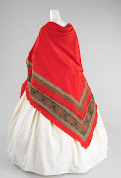When a mid-Victorian woman went out and needed a wrap or coat, she had a wide variety of types to choose from. From short and form-fitting basques to a completely loose shawl, there was the perfect garment for every need. As always, the weather, the event, the location, and the lady's income level determined what was appropriate for each occasion.
Outerwear in the mid-1800s was quite varied and often had overlapping names and descriptions. Following are some general terms and descriptions. This is not a comprehensive list.
This was a fitted jacket usually reaching to the hip area. They were often made of silk, wool, or a wool/silk blend. They were often closed with buttons. These could range from plain and functional to nicely trimmed and fashionable. Pictured is a wool and velvet basque.
 |
| Seen on Augusta Auctions |
Bournousse/Opera Cloak/Cape
This garment was a large piece of fabric with minimal shaping and with varying degrees of fullness. They could be of various lengths and have no arm holes or hidden armhole slits. They also had a front closure and were often trimmed to varying degrees. Popular materials for these were wool or a silk/wool blend. They were sometimes trimmed with fur. They were often paired with with a muff, especially for very cold weather. Pictured is a wool cape with embroidered soutache trim and tassels.
This dressy item was a sheer, fitted jacket ranging in length from hip to mid-calf. They were made of a sheer fabric or lace and often highly trimmed with lace, fringe, or velvet. This garment was for fashionable use only, obviously being too fragile for everyday or work wear. Pictured is a tambour net lace canezou with silk fringe.
Fichus
A mid-Victorian fichu was a gauzy, frilly, large collar or small shawl and was a carry-over fashion garment from the 18th century. They varied in shape, style, and fabric, from a small lacey confection to a longer, more dramatic fashion statement. Depending on style, they could be used for both day and evening wear. Pictured is a lace and velvet fichu.
This garment was sewn into a shape that fitted over the shoulders and arms, with no sleeves. They were generally about hip length. Mantles usually had pretty trim sewn onto them. They were could be made of silk, wool, and or sheer cotton or lace. Pictured is a silk mantle with fringe trim.
This fitted coat had multiple shaping seams, giving it a nice fluid silhouette. It was usually about knee length and made of wool or silk. It was generally meant for very cold weather and could be trimmed with fur, or embellished with soutache. Pictured is a wool paletot with deep fur trim and embellishments.
This was a coat that could be lightweight for summer wear or heavy for winter wear. Some were highly fitted while others were much more loose. It generally gave a triangular silhouette and usually reached from mid-calf to almost full-length. It was often made from wool or silk. Pictured is a sheer, lightweight summer version.
This is also called a sack coat or walking coat. A saque had little shaping and was approximately hip length. It was usually made of wool. It could be plain or highly embellished. Pictured is a wool saque embellished with silk soutache and beads.
Shawls could be quite large during this era. They were often rectangular or triangular. Common materials were wool and lace. Shawls could range in formality from an everyday serviceable wool for work, to beautifully embroidered or embellished lightweight wools and laces. Some were knitted with intricate designs and tassels. Paisley embroidered shawls from India were very also fashionable. Pictured is a beautifully woven wool shawl.
Also called a bosom buddy or bosom friend, this handy wrap-around garment was usually knitted and made of wool, though a few were made of quilted silk. It crossed the body and usually tied on with strings. It is perfect for active working situations where a lady needs her arms free. There are a number of patterns for knitting them in extant ladies' magazines. It can been worn for nice everyday wear or for work wear. Pictured is a lady wearing a knitted sontag with tasseled ties.
 |
| Seen on Pinterest |
Muff
This wonderful hand warming device was popular throughout the Victorian era. A common outside for the muff was fur, but there were also muffs covered with feathers, silk or crocheted from wool. The inside of the muff was often filled with feathers for warmth and then lined with silk or some other tight weave fabric that allowed the lady's hands to slip in smoothly. The ends of the muff were often tightened with a drawstring and the tassels were often quite decorative.










